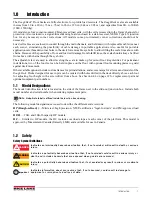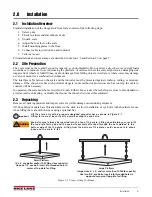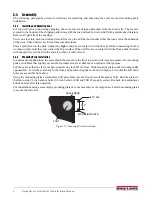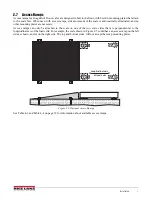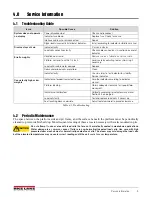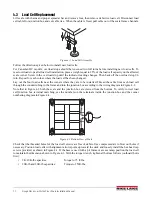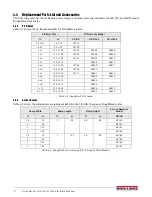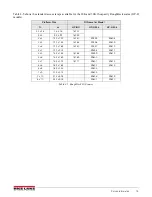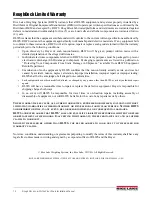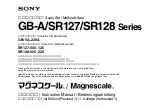
8
RoughDeck Low Profile Floor Scale Installation Manual
3.0
Adjustments and Calibration
3.1
Mechanical Adjustments
To accommodate minor floor unevenness, scale feet can be used to adjust scale height up or down a fraction of an
inch. Adjust the feet by hand (lift the scale corner slightly with a pry bar) until all feet are contacting the floor
equally. No jam nuts are supplied for locking the feet, as there is a slight decrease in accuracy when jam nuts are
tightened. If the application requires the feet to be secured, use Teflon tape or Loctite.
CAUTION
When adjusting scale feet, use care to prevent scale foot from bottoming out against the underside of the
load cell. Also, the foot stem may be damaged by bending or stripping threads if extended beyond the
maximum height adjustment.
When height adjustments are complete, recheck level of the deck with a spirit level. The deck must be level within
1/4".
3.2
Corner Correction
All assembled
RoughDeck
scales are delivered
with the junction box corner-trimmed. Corner
trimming is only necessary after replacing a load
cell.
JP4
JP2
PT4
PT3
JP3
PT1
EXP
PT2
JP1
1
CELL4
1
CELL1
1
CELL3
1
CELL2
IND
-EX
-SI
SHD
+SI
+EX
M
R
N
I
-SI
S2C
I
A
G
+EX
+SI
-SI
SHD
-EX
I
S
G
A
L
T
+SI
M
S
I
N
L
T
R
+EX
-EX
-SI
SHD
+SI
+EX
+SI
-EX
-SI
SHD
-EX
SHD
+SE
-SE
+EX
Potentiometers
Jumper Locations
JP1 and JP2
Shaded
Jumper Locations
JP3 and JP4
Shaded
Potentiometers
Figure 3-1. Trim Potentiometers
To calibrate the scale, the output from each load
cell must be matched by adjusting the signals
with potentiometers at the junction box. This
process is known as trimming.
Remove the junction box cover and identify the
correct load cell terminal corresponding to each
corner (labeled CELL 1, CELL 2, and so on).
See Figure 4-4 on page 11 for scale deck corner
numbering.
The indicator must be connected and calibrated
approximately, but it need not indicate the exact
weight value. A test weight will be required. The
recommended test weight for all
RoughDeck
models is 25% of scale capacity: for example,
500 lbs for 2K-lb models, 5000 lb for 20K-lb
models.
With no weight on the scale, zero the indicator.
Then turn all four potentiometers (shaded areas
of Figure ) to increase the reading until a clicking sound is heard from each potentiometer. This ensures the
maximum signal from each load cell.
With all potentiometers at full signal, place the test weight over one corner and record the indicated weight. Repeat
the process for each of the other three corners. The load cell with the lowest corner reading will be used as a
reference point and will not be trimmed.
Next, place the test weight over one of the other three corners and use that cell’s potentiometer to adjust the cell
output down to the reference cell output. Repeat this procedure with the other two high corners.
Adjustments are somewhat interactive, and adjusting the three higher outputs may affect the reference cell output,
especially in smaller scale decks. Rezero the indicator and repeat the test until all corners read within ±.1% of the
test weight used.
3.3
Calibration Procedure
Refer to the indicator manual to determine correct calibration procedures.
It is recommended that the scale be “exercised” before calibration to be certain that everything is seated. Load the
scale to near capacity two or three times.
Then, with no load on the scale, place the indicator in its calibration mode and perform a zero calibration. Now
place test weights on the platform equal to 70% - 80% of the scale’s capacity. If several weights are used, they
should be evenly distributed around the platform. Perform a span calibration.
Remove the test weights and check the zero reading. Repeat the calibration process if necessary.






